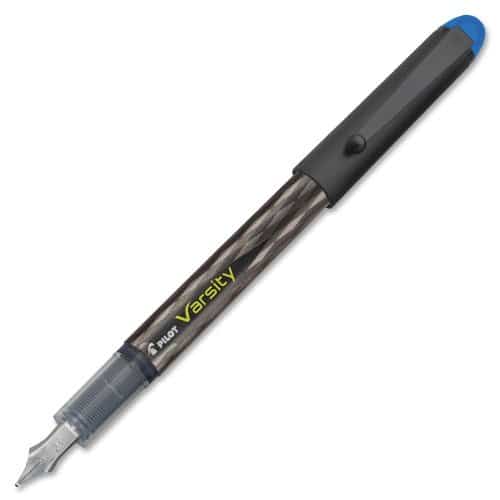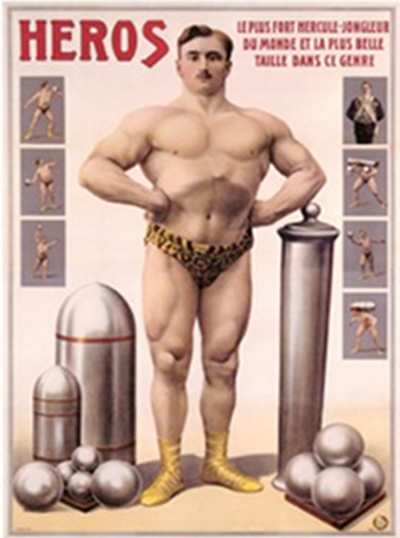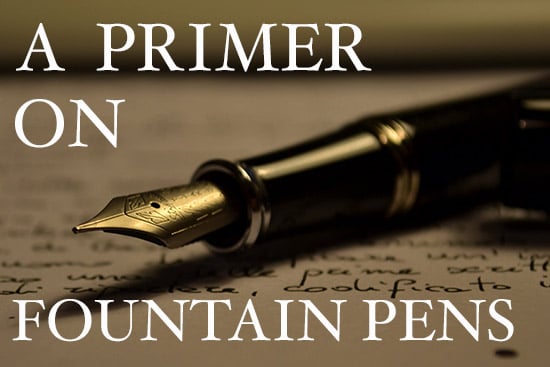
“To sit at one’s table on a sunny morning, with four clear hours of uninterruptible security, plenty of nice white paper, and a [fountain] pen — that is true happiness.” –Winston Churchill
Taking a break from click-clacking away at one’s keyboard to write something out by hand — a thank you note, a journal entry, a page of copywork — is a uniquely pleasurable activity.
And there are a few things one can do to heighten this pleasure, and its feeling of ritual.
One is applying your writing utensil to a handsome journal or quality stationery.
Another is improving your handwriting.
And then there’s using a fountain pen.
Putting aside one’s ballpoint and picking up a fountain pen is akin to making the switch from shaving with a cartridge razor to using a safety or straight razor. The nature of the tool requires more skill and attention on your part, but the experience is richer and the result sharper.
If you’ve always wanted to see what it’s like to literally get the ink flowing, this article offers an accessible primer on the basics you need to know to get started.
A Brief History of Fountain Pens
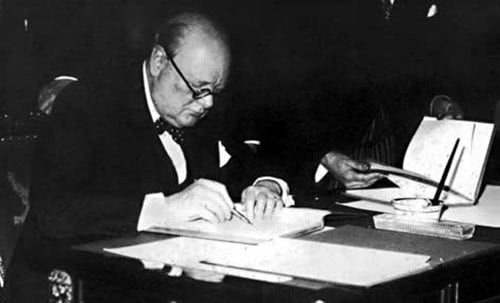
While the earliest record of a fountain-like pen dates from the 10th century, fountain pens as we know them today didn’t exist until the late 19th century. In 1884, an American named Lewis Waterman patented the first practical model after supposedly having a sales contract ruined by a leaky precursor. Before Waterman’s version, fountain pens were plagued with ink spills and blots, and were unreliable and inconvenient.
The main problem of earlier fountain pens centered on airflow — there wasn’t enough. Fountain pens work by managing the rate at which the ink flows through the pen. When the pen is held at an upright angle, ink from the reservoir is drawn downward by gravity, and goes through the feed and to the nib in a controlled fashion. Unless air is brought into the reservoir to replace the ink as it is used, a vacuum will build up that stops the flow.
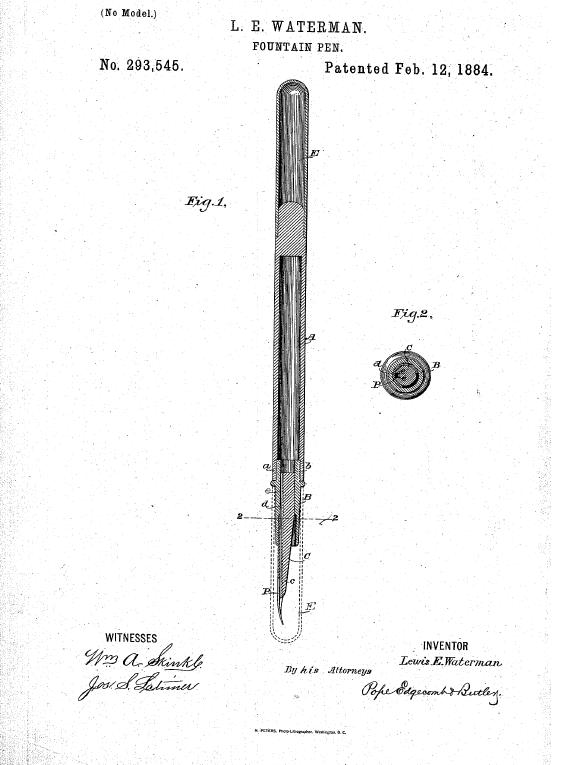
Waterman solved this airflow issue by cutting a series of three fissures in the pen’s feed. This created a capillary-esque mechanism that functioned by drawing ink into these small channels at the same time that air came back in over the fissures and entered the reservoir. The modern fountain pen was born.
Though Waterman’s innovation made fountain pens much more effective and convenient to write with, filling the pen remained a messy and tedious affair. You had to unscrew a portion of the barrel and use an eyedropper to fill the reservoir drop by drop. At the turn of the 20th century, companies began introducing self-filling reservoirs that allowed users to put the nib in the inkbottle and fill the reservoir by pulling a lever or twisting the barrel.
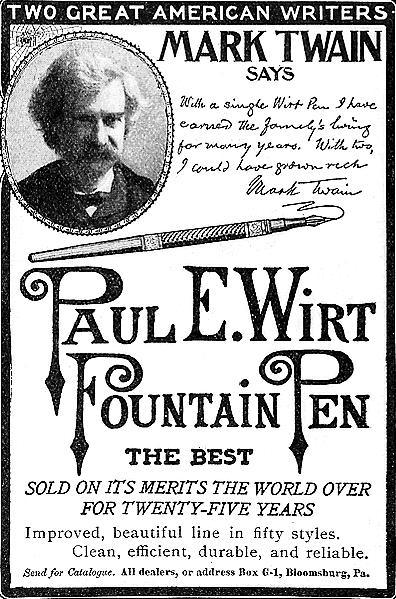
Despite the introduction of the ballpoint pen in the early 1900s, fountain pens maintained their dominance as the go-to writing instrument up until the mid-point of the century. It was not until the 1960s, when the ballpoint pen’s reliability increased, and its price decreased, that fountain pen sales began their long and steady decline in the United States. While they’re still widely used by students in private schools in England and the rest of Europe, in America the fountain pen is largely seen as more of a collector’s item, a status symbol, or the focus of a twee hobby. However, thanks to the internet’s ability to connect enthusiasts, the fountain pen has seen something of a resurgence in the U.S. Today you can find countless forums and blogs dedicated to the virtues of this classic writing instrument.
Why Write With a Fountain Pen
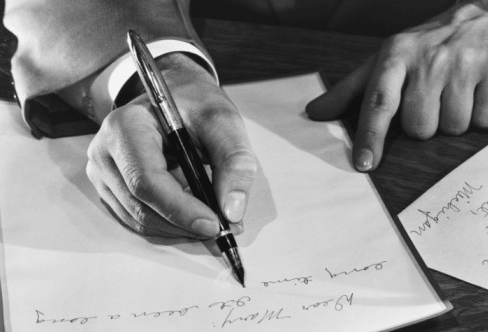
Think you might like to branch out from your ballpoint? Here are a few reasons to give fountain pens a try:
It feels better. Because you don’t have to press down as hard to write as you do with a ballpoint pen, writing with the fountain variety is much easier on the hand. It allows for extended periods of writing without fatigue. It’s easier to get in the flow, when using something that truly flows.
It’s better for the environment. With a ballpoint pen, once you use up all the ink, you toss it into the trash. While you can buy disposable fountain pens, most fountain pens aren’t meant to be thrown away. When you run out of ink, just refill the reservoir and you’re back in business.

More economical in the long run. I don’t want to think about the amount of money I’ve thrown away or lost in the form of half-used ballpoint pens. Because of their disposable nature, I’m pretty careless with them. If I lose one, oh well, I can buy a whole new pack of ‘em.
There’s something about a fountain pen that inspires you to take care of it. The hefty price tag of some models certainly has something to do with that. But the fountain pen’s storied tradition provides an aura of timelessness and permanence that encourages the owner to safeguard it; it may even become a family heirloom.
The result is that, besides the initial investment of the pen, the only recurring expense you’ll accrue is just buying more ink every now and then. Consequently, you save money in the long run with a fountain pen compared to a ballpoint.
It makes cursive handwriting look better. Besides reducing fatigue, the light touch and flowing hand movements that are necessitated by a fountain pen make your handwriting look better.
It makes you feel like a sir. I’ll admit it — one of the appeals of writing with a fountain pen is that it just makes you feel awesome. There’s something about writing with the same implement that Teddy Roosevelt and Winston Churchill used that makes you feel like a true gentleman and scholar.
The Anatomy of a Fountain Pen

The fountain pen’s design is sophisticatedly simple. It consists of three main parts: the nib, the feed, and the filling system.
Nibs
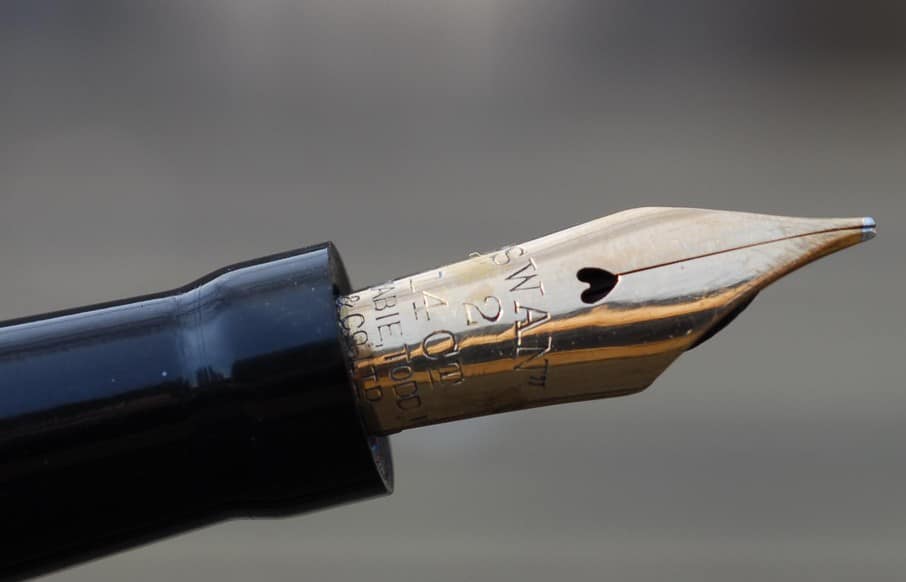
Notice the slit down the middle and the breather hole.
The nib is the metal tip of the fountain pen that touches the paper. Early fountain pen nibs were fashioned from gold due to the element’s flexibility and resistance to corrosion. However, most modern nibs are made with stainless steel or gold alloys because of their strength and durability.
If a nib is made from pure gold, it’s usually tipped with a hard-wearing metal like iridium or some metal from the platinum family. Steel nibs already have a hard tip, so tipping them with another metal isn’t necessary.
Along the center of the nib runs a small slit that helps bring ink down the tip by way of the aforementioned capillary action. You’ll also find a “breather hole” bored into the top of the nib to help bring air back into the reservoir to prevent a vacuum from forming. The breather hole also serves a structural purpose by acting as a stress-relieving point, which helps prevent the nib from cracking with the repeated flexing that occurs during use.
Nibs come in varying tip shapes and grades. The three basic shapes are round, stub, and italic. Round is the most common shape and provides a fairly uniform-looking line on the paper. Stub and italic nibs are typically used in calligraphy.
Nib grades designate the size of the tip. Five basic grades exist: extra fine (XF), fine (F), medium (M), broad (B), and double broad (BB). The most common nib grades are fine and extra fine.
Feeds

Part of the feed hugging the bottom of the nib.
The feed is the piece of black plastic (or ebonite on antique pens) that hugs the bottom of the nib. It might not look like it, but the feed is the most important part of a fountain pen. It provides the route by which ink travels from the reservoir to the nib, and by which air fills the reservoir.
Ever since Waterman patented his feed design in 1884, pen makers have strived to create better and more efficient feeds. In 1941, the Parker Company introduced one of the most notable upgrades by adding a “collector” to the feed. On modern fountain pens, the collector is a visible set of grooves or fins just beneath the nib. The collector acts as a second reservoir and keeps the nib well supplied with ink while also preventing too much ink from flowing out at once.
Reservoir or Filling Systems
The reservoir is the cavity inside the fountain pen that holds the ink. This part has seen the most innovations over the course of the pen’s evolution. We could devote an entire article to the various types of reservoirs and filling systems that you can find on antique fountain pens, but for the purposes of this article, we’ll stick to the most common ones you’ll find in modern models:
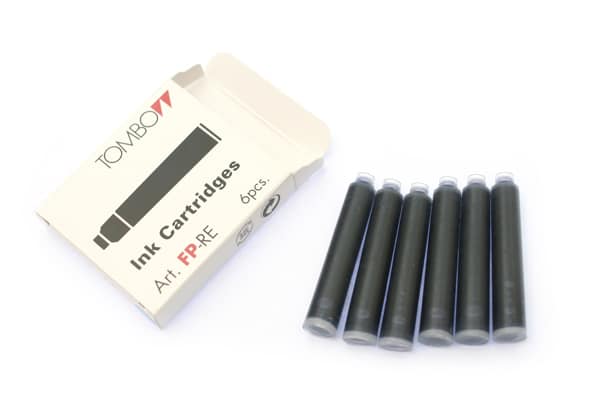
Cartridge. This is the most common type of reservoir in fountain pens today. A cartridge is a small, sealed disposable plastic tube that holds the fountain pen ink. When a cartridge runs out of ink, you simply remove the old cartridge and put in a new one. The main benefit of cartridge reservoirs is the convenience. The downside is that you often have to rely on the propriety cartridge made for your particular pen. Consequently, your choices of ink will be more limited. Also, there’s the cost factor. While cartridges aren’t too expensive, refilling your pen yourself can save you money in the long run.
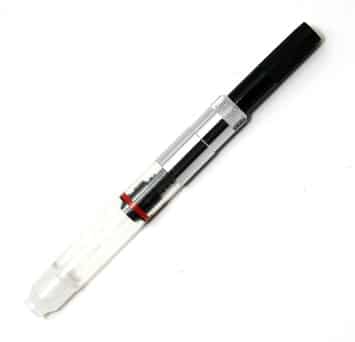
Converter. If you don’t like the idea of having to buy new cartridges every time you run out of ink, consider buying a cartridge converter for your fountain pen. A cartridge converter looks pretty much like a cartridge and can fit most cartridge pens, but it has a filling mechanism that allows you to refill it with ink whenever you run out. The upside is that you open yourself up to a variety of inks to use, the downside is convenience; while it’s not hard to fill your cartridge converter, it’s certainly more of a hassle than simply throwing away an old cartridge and installing a new one. Here’s how to fill a cartridge converter.

Piston. This filling system relies on a screw mechanism that draws a piston up the barrel, sucking in ink through the nib and into the reservoir. It’s basically a built-in converter. The only downside (if you can call it a downside) on a pen with a piston filling mechanism, is that you’ll never be able to use cartridges with it. You have to fill it up manually every single time. Here’s how to fill a piston style pen.
Best Fountain Pens for Beginners
If want to give fountain pens a try, but aren’t ready to drop $100 for a fancy pen, consider trying the following three models:
Varsity Fountain Pen by Pilot. These are disposable, so you’re not going to get the “true” fountain pen experience with them. But at $8 for a pack of three, it’s a great way to give fountain pens a try without much investment. The big downside I’ve found is that the ink feathers on most types of paper, causing my handwriting to sometimes become less legible.

Lamy Safari. After lurking on several fountain pen forums and polling the aficionados among my Twitter followers, it became clear that the Lamy Safari was hands down the most recommend fountain pen for beginners. With a ~$20 price tag, it’s a great reusable/refillable fountain pen for the man just getting started.

Pilot Metropolitan. Right behind the chorus of recommendations for the Lamy Safari was the Pilot Metropolitan. It’s a sharp looking pen that writes well and costs a mere $15.
How to Write With a Fountain Pen
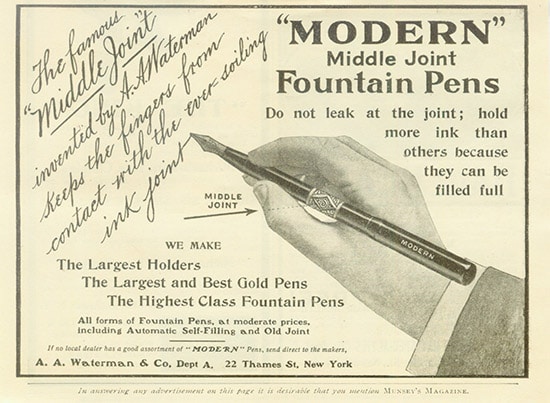
Post your cap (or not). Posting your cap means putting the cap on the end of your pen while you’re writing. The pen usually feels more balanced in the hand when you have it posted. Of course, some folks prefer to write with the cap set aside. Experiment and find what works for you.
Hold it at the correct angle. The pen should make a 40 to 55-degree angle with your writing surface. A fountain pen’s “sweet spot” is usually in this range, as ink flows more easily at these angles. The exception is a pen with a round nib; in this case, you want the nib’s top to point straight up and not be rotated to either side.
Use less pressure. You don’t need to press down to get the ink to flow like you do with a ballpoint pen. In fact, too much pressure can prevent the ink from flowing properly or can damage the nib. Keep your strokes light.
Use your arm. Most people are “finger writers,” meaning that they just move their fingers to write. Finger writing has a tendency to cause you to apply too much pressure to the pen, which rotates it and in turn causes ink flow problems. Instead, focus on using your shoulder and arm more while you’re writing. It will feel weird at first, but this style of writing keeps your nib steady and helps reduce the pressure on it.
How to Take Care of Your Fountain Pen
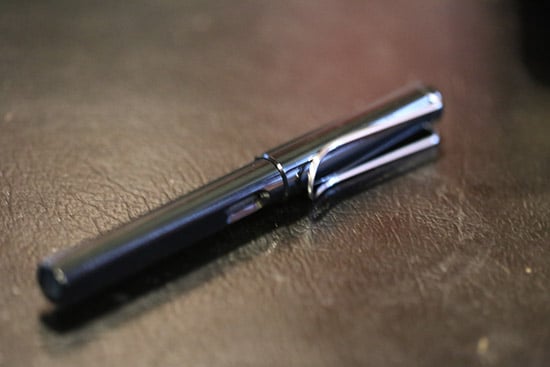
Always keep your pen’s cap on when not in use.
Keep the cap on when the pen is not in use. This prevents the ink on your nib from drying up and protects the nib from damage. If you do happen to leave your pen uncapped and find that the ink has dried up, you’ll need to remove the dried ink that’s blocking the flow. Soaking the nib with water can often do the trick. If that doesn’t work, consider doing a complete flush of your pen — repeatedly filling it and emptying it with cool water.
Don’t let others borrow your pen. As you use your pen, the nib will adapt to your writing style. If you let someone else borrow it for extended periods and apply their own style to it, the nib can get out of whack. If they just need to sign something, let them borrow it; it’s a gentlemanly gesture. If they need to write an essay, lend them a cheap-o ballpoint.
Give your pen a regular flush. It’s recommended that you give your fountain pen a flush once a month. It ensures proper ink flow by removing any build-up in the nib or feed. Here’s how you do it.
In addition to flushing, you might consider soaking your nib in a cup of cool water overnight to remove any stubborn ink build-up.
Becoming a Fountain Pen Aficionado
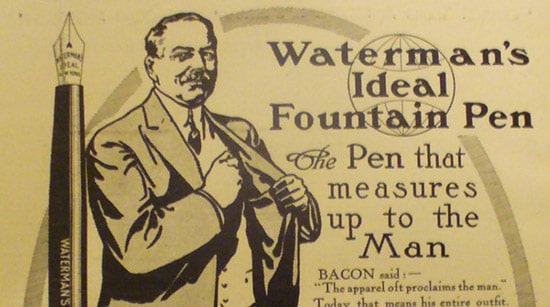
This post just scratched (see what I did there?) the surface of the fountain pen world. We didn’t even get into antique fountain pens. Hopefully, a true fountain pen aficionado will be up for writing that article for us. (Nudge, nudge.) If you want to learn more about fountain pens, I highly recommend you check out the following sources:
Richardspens.com. This is THE source on fountain pens on the web. I spent hours just reading through the in-depth articles he has on every aspect of fountain pens. This site is a must-read for anyone wanting to learn more about them.
The Fountain Pen Network. A forum dedicated to fountain pens. The folks there are super helpful with beginners, so if you have a question, ask. They also have lists of groups, meetings and events dedicated to fountain penning (yeah, I just used fountain pen as a verb), as well as a marketplace where you can buy or trade new fountain pens.
Fountain Pen Board. A smaller, more tight-knit forum than Fountain Pen Network. Ask questions or buy or sell your antique fountain pens.
Fountain Pen Geeks. Another fountain pen forum.
Tags: Writing

